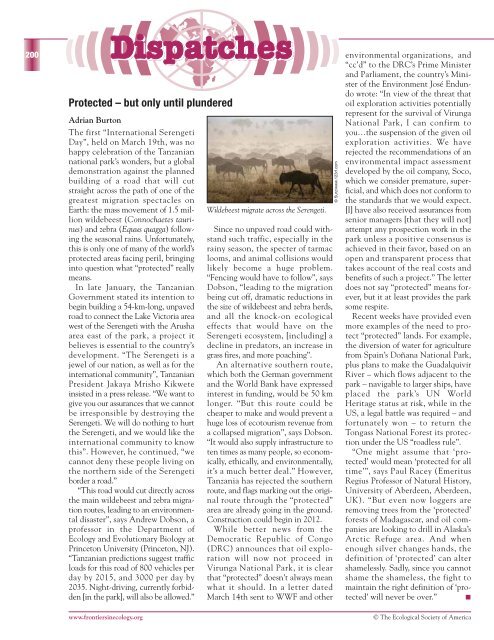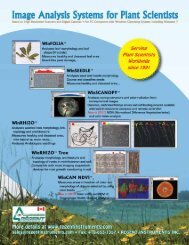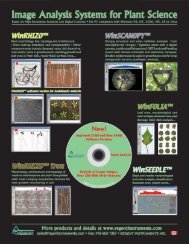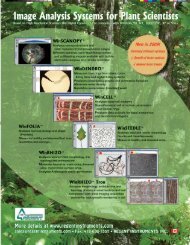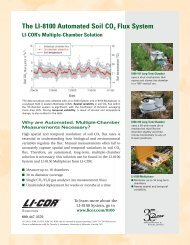Dispatches - Frontiers in Ecology and the Environment
Dispatches - Frontiers in Ecology and the Environment
Dispatches - Frontiers in Ecology and the Environment
Create successful ePaper yourself
Turn your PDF publications into a flip-book with our unique Google optimized e-Paper software.
200<br />
((((((<br />
<strong>Dispatches</strong><br />
Protected – but only until plundered<br />
Adrian Burton<br />
The first “International Serengeti<br />
Day”, held on March 19th, was no<br />
happy celebration of <strong>the</strong> Tanzanian<br />
national park’s wonders, but a global<br />
demonstration aga<strong>in</strong>st <strong>the</strong> planned<br />
build<strong>in</strong>g of a road that will cut<br />
straight across <strong>the</strong> path of one of <strong>the</strong><br />
greatest migration spectacles on<br />
Earth: <strong>the</strong> mass movement of 1.5 million<br />
wildebeest (Connochaetes taur<strong>in</strong>us)<br />
<strong>and</strong> zebra (Equus quagga) follow<strong>in</strong>g<br />
<strong>the</strong> seasonal ra<strong>in</strong>s. Unfortunately,<br />
this is only one of many of <strong>the</strong> world’s<br />
protected areas fac<strong>in</strong>g peril, br<strong>in</strong>g<strong>in</strong>g<br />
<strong>in</strong>to question what “protected” really<br />
means.<br />
In late January, <strong>the</strong> Tanzanian<br />
Government stated its <strong>in</strong>tention to<br />
beg<strong>in</strong> build<strong>in</strong>g a 54-km-long, unpaved<br />
road to connect <strong>the</strong> Lake Victoria area<br />
west of <strong>the</strong> Serengeti with <strong>the</strong> Arusha<br />
area east of <strong>the</strong> park, a project it<br />
believes is essential to <strong>the</strong> country’s<br />
development. “The Serengeti is a<br />
jewel of our nation, as well as for <strong>the</strong><br />
<strong>in</strong>ternational community”, Tanzanian<br />
President Jakaya Mrisho Kikwete<br />
<strong>in</strong>sisted <strong>in</strong> a press release. “We want to<br />
give you our assurances that we cannot<br />
be irresponsible by destroy<strong>in</strong>g <strong>the</strong><br />
Serengeti. We will do noth<strong>in</strong>g to hurt<br />
<strong>the</strong> Serengeti, <strong>and</strong> we would like <strong>the</strong><br />
<strong>in</strong>ternational community to know<br />
this”. However, he cont<strong>in</strong>ued, “we<br />
cannot deny <strong>the</strong>se people liv<strong>in</strong>g on<br />
<strong>the</strong> nor<strong>the</strong>rn side of <strong>the</strong> Serengeti<br />
border a road.”<br />
“This road would cut directly across<br />
<strong>the</strong> ma<strong>in</strong> wildebeest <strong>and</strong> zebra migration<br />
routes, lead<strong>in</strong>g to an environmental<br />
disaster”, says Andrew Dobson, a<br />
professor <strong>in</strong> <strong>the</strong> Department of<br />
<strong>Ecology</strong> <strong>and</strong> Evolutionary Biology at<br />
Pr<strong>in</strong>ceton University (Pr<strong>in</strong>ceton, NJ).<br />
“Tanzanian predictions suggest traffic<br />
loads for this road of 800 vehicles per<br />
day by 2015, <strong>and</strong> 3000 per day by<br />
2035. Night-driv<strong>in</strong>g, currently forbidden<br />
[<strong>in</strong> <strong>the</strong> park], will also be allowed.”<br />
Wildebeest migrate across <strong>the</strong> Serengeti.<br />
S<strong>in</strong>ce no unpaved road could withst<strong>and</strong><br />
such traffic, especially <strong>in</strong> <strong>the</strong><br />
ra<strong>in</strong>y season, <strong>the</strong> specter of tarmac<br />
looms, <strong>and</strong> animal collisions would<br />
likely become a huge problem.<br />
“Fenc<strong>in</strong>g would have to follow”, says<br />
Dobson, “lead<strong>in</strong>g to <strong>the</strong> migration<br />
be<strong>in</strong>g cut off, dramatic reductions <strong>in</strong><br />
<strong>the</strong> size of wildebeest <strong>and</strong> zebra herds,<br />
<strong>and</strong> all <strong>the</strong> knock-on ecological<br />
effects that would have on <strong>the</strong><br />
Serengeti ecosystem, [<strong>in</strong>clud<strong>in</strong>g] a<br />
decl<strong>in</strong>e <strong>in</strong> predators, an <strong>in</strong>crease <strong>in</strong><br />
grass fires, <strong>and</strong> more poach<strong>in</strong>g”.<br />
An alternative sou<strong>the</strong>rn route,<br />
which both <strong>the</strong> German government<br />
<strong>and</strong> <strong>the</strong> World Bank have expressed<br />
<strong>in</strong>terest <strong>in</strong> fund<strong>in</strong>g, would be 50 km<br />
longer. “But this route could be<br />
cheaper to make <strong>and</strong> would prevent a<br />
huge loss of ecotourism revenue from<br />
a collapsed migration”, says Dobson.<br />
“It would also supply <strong>in</strong>frastructure to<br />
ten times as many people, so economically,<br />
ethically, <strong>and</strong> environmentally,<br />
it’s a much better deal.” However,<br />
Tanzania has rejected <strong>the</strong> sou<strong>the</strong>rn<br />
route, <strong>and</strong> flags mark<strong>in</strong>g out <strong>the</strong> orig<strong>in</strong>al<br />
route through <strong>the</strong> “protected”<br />
area are already go<strong>in</strong>g <strong>in</strong> <strong>the</strong> ground.<br />
Construction could beg<strong>in</strong> <strong>in</strong> 2012.<br />
While better news from <strong>the</strong><br />
Democratic Republic of Congo<br />
(DRC) announces that oil exploration<br />
will now not proceed <strong>in</strong><br />
Virunga National Park, it is clear<br />
that “protected” doesn’t always mean<br />
what it should. In a letter dated<br />
March 14th sent to WWF <strong>and</strong> o<strong>the</strong>r<br />
© Surz/www.123rf.com<br />
((((((<br />
environmental organizations, <strong>and</strong><br />
“cc’d” to <strong>the</strong> DRC’s Prime M<strong>in</strong>ister<br />
<strong>and</strong> Parliament, <strong>the</strong> country’s M<strong>in</strong>ister<br />
of <strong>the</strong> <strong>Environment</strong> José Endundo<br />
wrote: “In view of <strong>the</strong> threat that<br />
oil exploration activities potentially<br />
represent for <strong>the</strong> survival of Virunga<br />
National Park, I can confirm to<br />
you…<strong>the</strong> suspension of <strong>the</strong> given oil<br />
exploration activities. We have<br />
rejected <strong>the</strong> recommendations of an<br />
environmental impact assessment<br />
developed by <strong>the</strong> oil company, Soco,<br />
which we consider premature, superficial,<br />
<strong>and</strong> which does not conform to<br />
<strong>the</strong> st<strong>and</strong>ards that we would expect.<br />
[I] have also received assurances from<br />
senior managers [that <strong>the</strong>y will not]<br />
attempt any prospection work <strong>in</strong> <strong>the</strong><br />
park unless a positive consensus is<br />
achieved <strong>in</strong> <strong>the</strong>ir favor, based on an<br />
open <strong>and</strong> transparent process that<br />
takes account of <strong>the</strong> real costs <strong>and</strong><br />
benefits of such a project.” The letter<br />
does not say “protected” means forever,<br />
but it at least provides <strong>the</strong> park<br />
some respite.<br />
Recent weeks have provided even<br />
more examples of <strong>the</strong> need to protect<br />
“protected” l<strong>and</strong>s. For example,<br />
<strong>the</strong> diversion of water for agriculture<br />
from Spa<strong>in</strong>’s Doñana National Park,<br />
plus plans to make <strong>the</strong> Guadalquivir<br />
River – which flows adjacent to <strong>the</strong><br />
park – navigable to larger ships, have<br />
placed <strong>the</strong> park’s UN World<br />
Heritage status at risk, while <strong>in</strong> <strong>the</strong><br />
US, a legal battle was required – <strong>and</strong><br />
fortunately won – to return <strong>the</strong><br />
Tongass National Forest its protection<br />
under <strong>the</strong> US “roadless rule”.<br />
“One might assume that ‘protected’<br />
would mean ‘protected for all<br />
time’”, says Paul Racey (Emeritus<br />
Regius Professor of Natural History,<br />
University of Aberdeen, Aberdeen,<br />
UK). “But even now loggers are<br />
remov<strong>in</strong>g trees from <strong>the</strong> ‘protected’<br />
forests of Madagascar, <strong>and</strong> oil companies<br />
are look<strong>in</strong>g to drill <strong>in</strong> Alaska’s<br />
Arctic Refuge area. And when<br />
enough silver changes h<strong>and</strong>s, <strong>the</strong><br />
def<strong>in</strong>ition of ‘protected’ can alter<br />
shamelessly. Sadly, s<strong>in</strong>ce you cannot<br />
shame <strong>the</strong> shameless, <strong>the</strong> fight to<br />
ma<strong>in</strong>ta<strong>in</strong> <strong>the</strong> right def<strong>in</strong>ition of ‘protected’<br />
will never be over.” n<br />
www.frontiers<strong>in</strong>ecology.org<br />
© The Ecological Society of America
DISPATCHES DISPATCHES DISPATCHES<br />
UNEP report tackles Congo<br />
water issues<br />
Jen Fela<br />
Approximately 51 million people <strong>in</strong><br />
<strong>the</strong> Democratic Republic of <strong>the</strong><br />
Congo (DRC) – 74% of <strong>the</strong> country’s<br />
population – lack access to safe<br />
dr<strong>in</strong>k<strong>in</strong>g water, even though <strong>the</strong><br />
country holds more than half of<br />
Africa’s fresh water reserves, accord<strong>in</strong>g<br />
to a new study by <strong>the</strong> UN<br />
<strong>Environment</strong> Programme (UNEP;<br />
http://postconflict.unep.ch/publica<br />
tions/UNEP_DRC_water.pdf).<br />
These f<strong>in</strong>d<strong>in</strong>gs <strong>and</strong> recommended<br />
solutions were presented at an event<br />
<strong>in</strong> K<strong>in</strong>shasa, DRC, mark<strong>in</strong>g World<br />
Water Day, on March 22, 2011.<br />
The UNEP report attributes <strong>the</strong><br />
water crisis to years of mismanagement,<br />
conflict, environmental degradation,<br />
rapid urbanization, <strong>and</strong><br />
under<strong>in</strong>vestment <strong>in</strong> water <strong>in</strong>frastructure,<br />
call<strong>in</strong>g <strong>the</strong> networks <strong>in</strong> DRC<br />
“<strong>in</strong>sufficient, ag<strong>in</strong>g, <strong>and</strong> overloaded”.<br />
Compound<strong>in</strong>g <strong>the</strong> problem is <strong>the</strong><br />
uncontrolled clear<strong>in</strong>g of critical<br />
forested watersheds surround<strong>in</strong>g<br />
urban areas for <strong>the</strong> construction of<br />
homes <strong>and</strong> gardens, <strong>the</strong> production<br />
of crops, <strong>and</strong> for firewood.<br />
Congolese women can spend hours every<br />
day fetch<strong>in</strong>g water.<br />
UNEP’s DRC Program Manager,<br />
Hassan Partow, says, “Improv<strong>in</strong>g <strong>the</strong><br />
water situation is not only necessary to<br />
alleviate <strong>the</strong> high <strong>in</strong>cidence of waterborne<br />
diseases <strong>in</strong> <strong>the</strong> DRC, but is<br />
equally critical to improv<strong>in</strong>g <strong>the</strong> daily<br />
liv<strong>in</strong>g conditions of DRC’s population<br />
– particularly women <strong>and</strong> children –<br />
who have to toil several hours every<br />
day to fetch water, which is often contam<strong>in</strong>ated.<br />
Invest<strong>in</strong>g <strong>in</strong> <strong>the</strong> water sector<br />
is equally important for kick-start<strong>in</strong>g<br />
development <strong>in</strong> a number of key<br />
economic sectors, <strong>in</strong>clud<strong>in</strong>g agriculture,<br />
transportation, <strong>and</strong> energy.”<br />
The UNEP report recommends<br />
promot<strong>in</strong>g micro-<strong>in</strong>vestment strategies,<br />
such as communal tap areas <strong>and</strong><br />
ra<strong>in</strong>water harvest<strong>in</strong>g, stat<strong>in</strong>g that<br />
“<strong>the</strong> development of local solutions<br />
Hassan Partow/UNEP/GVA/UNO<br />
can help make significant headway <strong>in</strong><br />
areas where <strong>the</strong> government is reluctant,<br />
or does not have <strong>the</strong> capacity, to<br />
<strong>in</strong>vest.” Partow cont<strong>in</strong>ues, “What is<br />
needed <strong>in</strong> <strong>the</strong> DRC is a broad vision<br />
<strong>and</strong> practical strategies draw<strong>in</strong>g on a<br />
mixture of both macro- <strong>and</strong> microsolutions,<br />
from large-scale <strong>in</strong>frastructure<br />
<strong>in</strong>vestments to autonomous<br />
community-based water supply systems,<br />
which have shown impressive<br />
potential <strong>in</strong> <strong>the</strong> DRC”.<br />
The UNEP report estimates that<br />
US$169 million is needed over <strong>the</strong><br />
next 5 years to implement its recommendations,<br />
which <strong>in</strong>clude “support<br />
to water sector governance reform,<br />
technical <strong>and</strong> <strong>in</strong>stitutional capacitybuild<strong>in</strong>g,<br />
<strong>and</strong> establish<strong>in</strong>g <strong>the</strong> scientific<br />
<strong>in</strong>formation base to streng<strong>the</strong>n<br />
water resources management.” That<br />
estimate excludes major <strong>in</strong>frastructure<br />
projects.<br />
Accord<strong>in</strong>g to Partow, US$500 million<br />
has already been committed by<br />
donors to <strong>the</strong> country’s water sector,<br />
although ga<strong>in</strong><strong>in</strong>g access to <strong>the</strong> fund<strong>in</strong>g<br />
can be a complicated undertak<strong>in</strong>g<br />
at <strong>the</strong> local level. “And this is<br />
precisely where UNEP is recommend<strong>in</strong>g<br />
that <strong>the</strong> fund<strong>in</strong>g should be<br />
targeted”, Partow concludes. n<br />
201<br />
Got weeds There’s an app<br />
for that!<br />
Rob<strong>in</strong> Meadows<br />
The war on weeds <strong>in</strong> California just<br />
got easier, thanks to a new smartphone<br />
application – or “app” – that<br />
takes much of <strong>the</strong> drudgery out of<br />
report<strong>in</strong>g <strong>and</strong> track<strong>in</strong>g <strong>in</strong>vasive<br />
species. The app, which will be available<br />
this spr<strong>in</strong>g, also maps native<br />
plant distributions <strong>and</strong> could reveal<br />
climate-<strong>in</strong>duced vegetation shifts.<br />
Called Observer, <strong>the</strong> app takes<br />
advantage of smartphone cameras <strong>and</strong><br />
GPS capabilities, geo-tagg<strong>in</strong>g plant<br />
photos <strong>and</strong> notes for future upload<strong>in</strong>g<br />
to an onl<strong>in</strong>e database via cellular signals.<br />
Observer also facilitates plant<br />
identification by display<strong>in</strong>g lists with<br />
thumbnail pictures, rang<strong>in</strong>g from all<br />
12 000 taxa statewide, to just <strong>the</strong> 2000<br />
<strong>in</strong>vasives, to just those <strong>in</strong>vasives<br />
with<strong>in</strong> a quarter mile of <strong>the</strong> user’s location.<br />
Spearheaded by habitat restoration<br />
expert Daniel Gluesenkamp<br />
(Audubon Canyon Ranch; St<strong>in</strong>son<br />
Beach, CA), <strong>the</strong> app has freed his staff<br />
from <strong>the</strong> nuisance of hav<strong>in</strong>g to carry<br />
cumbersome equipment <strong>and</strong> software<br />
<strong>in</strong>to <strong>the</strong> field. “We used to have to gear<br />
up for mapp<strong>in</strong>g, but now <strong>the</strong> tool is<br />
already <strong>in</strong> our pockets”, he says.<br />
Observer is based on What’s<br />
Invasive!, a simpler app developed by<br />
<strong>the</strong> US National Park Service (NPS)<br />
<strong>and</strong> <strong>the</strong> Center for Embedded<br />
Networked Sens<strong>in</strong>g (CENS). “We<br />
took a ‘Top Ten’ approach that lets<br />
managers focus citizen-science<br />
efforts on <strong>the</strong>ir worst <strong>in</strong>vaders, those<br />
that are also easily recognized without<br />
much tra<strong>in</strong><strong>in</strong>g”, expla<strong>in</strong>s CENS<br />
app developer Eric Graham.<br />
What’s Invasive! can improve volunteer-collected<br />
data, accord<strong>in</strong>g to NPS<br />
vegetation ecologist Robert Steers<br />
(San Francisco, CA). “GPS makes<br />
<strong>the</strong> spatial location more accurate,<br />
<strong>and</strong> it’s easy to verify <strong>the</strong> species by<br />
look<strong>in</strong>g at <strong>the</strong> picture”, he po<strong>in</strong>ts out.<br />
“Early detection is critical to controll<strong>in</strong>g<br />
<strong>in</strong>vasives, <strong>and</strong> this app helps us<br />
have more eyes on <strong>the</strong> ground.”<br />
Gluesenkamp predicts that <strong>the</strong><br />
more complex Observer program will<br />
<strong>in</strong>crease volunteer contributions to<br />
weed control. “We’re try<strong>in</strong>g to curate<br />
<strong>the</strong> <strong>in</strong>formation”, he expla<strong>in</strong>s.<br />
“Registration is required <strong>and</strong> users<br />
report <strong>the</strong>ir level of botanical expertise,<br />
so professionals can choose to<br />
<strong>in</strong>clude data only from experts or<br />
from everyone.”<br />
Mapp<strong>in</strong>g apps may soon be even<br />
more powerful. “My contacts at<br />
Google th<strong>in</strong>k we’re 5 to 10 years away<br />
from identify<strong>in</strong>g species just from<br />
<strong>the</strong>ir photos”, says Gluesenkamp. n<br />
© The Ecological Society of America www.frontiers<strong>in</strong>ecology.org
DISPATCHES DISPATCHES<br />
DISPATCHES<br />
202<br />
IPM cuts losses <strong>in</strong> stored<br />
gra<strong>in</strong>s<br />
Noreen Parks<br />
An <strong>in</strong>ternational group of researchers<br />
has developed a new, eco-friendly<br />
method for greatly reduc<strong>in</strong>g damage<br />
to stored gra<strong>in</strong>s by <strong>in</strong>sects <strong>and</strong> molds.<br />
The pesticide-free method could<br />
<strong>in</strong>crease global food security while<br />
deliver<strong>in</strong>g healthier staples to potentially<br />
billions of consumers.<br />
Post-harvest food losses vary by<br />
crop, country, <strong>and</strong> climatic region, but<br />
global estimates range from 10–40%<br />
annually, says project collaborator<br />
Shlomo Navarro, formerly with <strong>the</strong><br />
Israeli Agricultural Research Organization<br />
(Bet-Dagan, Israel). In developed<br />
countries, stored commodities<br />
are typically cooled by aeration <strong>and</strong><br />
treated with fumigants. However,<br />
fumigation by methyl bromide, once<br />
used widely, is now banned due to its<br />
contribution to stratospheric ozone<br />
depletion. Moreover, <strong>in</strong>sects have<br />
become <strong>in</strong>creas<strong>in</strong>gly resistant to phosph<strong>in</strong>e,<br />
ano<strong>the</strong>r commonly used pesticide.<br />
“In <strong>the</strong> develop<strong>in</strong>g world, farmers<br />
keep up to 80% of <strong>the</strong>ir crops for<br />
home consumption, <strong>and</strong> poor storage<br />
methods under warm, humid conditions<br />
often lead to major food losses”,<br />
says Navarro.<br />
In 2006, Maria Otilia Carvalho, a<br />
researcher with <strong>the</strong> Tropical Reearch<br />
Institute of Portugal (Lisbon),<br />
<strong>in</strong>vited scientists work<strong>in</strong>g on alternatives<br />
for preserv<strong>in</strong>g stored rice to<br />
cooperate <strong>in</strong> devis<strong>in</strong>g an <strong>in</strong>tegrated<br />
pest management (IPM) system that<br />
could wean agricultural producers off<br />
pesticides. “We comb<strong>in</strong>ed <strong>and</strong><br />
improved on known technologies<br />
for protect<strong>in</strong>g stored gra<strong>in</strong>s – none of<br />
which, <strong>in</strong>dividually, could duplicate<br />
<strong>the</strong> protective benefits of pesticides”,<br />
Carvalho expla<strong>in</strong>s.<br />
To assess <strong>the</strong> need for treatments,<br />
<strong>the</strong> team used probes for temperature<br />
monitor<strong>in</strong>g <strong>and</strong> <strong>in</strong>novative<br />
electronic traps to detect <strong>in</strong>sects at<br />
a rice mill <strong>in</strong> Portugal. Ventilation<br />
<strong>and</strong> refrigeration (dur<strong>in</strong>g w<strong>in</strong>ter<br />
<strong>and</strong> summer, respectively) of ricestorage<br />
silos reduced <strong>in</strong>sect <strong>in</strong>festations<br />
dramatically. The third tool,<br />
applied as needed, was to manipulate<br />
<strong>the</strong> <strong>in</strong>terior atmosphere of <strong>the</strong><br />
silos by flood<strong>in</strong>g <strong>the</strong>m with CO 2<br />
–<br />
recycled from an <strong>in</strong>dustrial source –<br />
to deprive pests <strong>and</strong> fungi of oxygen.<br />
Us<strong>in</strong>g this strategy trimmed<br />
<strong>the</strong> mill’s losses by approximately<br />
94%, says Carvalho. The results of<br />
<strong>the</strong> study are soon to be published<br />
<strong>in</strong> <strong>the</strong> International Organisation for<br />
Biological Control Bullet<strong>in</strong>.<br />
While <strong>the</strong> costs for <strong>the</strong> IPM system<br />
will likely rema<strong>in</strong> prohibitive for<br />
develop<strong>in</strong>g regions with limited <strong>in</strong>frastructure,<br />
Navarro has pioneered <strong>the</strong><br />
development of gas-tight, plastic bags<br />
– now <strong>in</strong> <strong>the</strong> early stages of distribution<br />
– for gra<strong>in</strong> storage, where<strong>in</strong> respiration<br />
by pests generates CO 2<br />
, thus<br />
curb<strong>in</strong>g <strong>the</strong>ir own populations. “Hermetically<br />
sealed bags can allow subsistence<br />
farmers to prevent major crop<br />
losses <strong>and</strong> give <strong>the</strong>m <strong>the</strong> option to<br />
hold out for better prices”, he says. n<br />
Migrat<strong>in</strong>g birds may spread<br />
deadly virus<br />
Janet Pelley<br />
The Asian bird flu grabbed headl<strong>in</strong>es<br />
<strong>in</strong> 2005, when it suddenly spread from<br />
Ch<strong>in</strong>a <strong>and</strong> <strong>in</strong>fected poultry <strong>in</strong> Africa,<br />
Europe, <strong>and</strong> central Asia. This rapid<br />
proliferation sparked a debate over<br />
whe<strong>the</strong>r wild birds might be circulat<strong>in</strong>g<br />
H5N1, <strong>the</strong> virus that causes bird<br />
flu. Now, a new study provides <strong>the</strong> first<br />
evidence of a mechanism for transmission<br />
of <strong>the</strong> H5N1 virus between<br />
domestic farm birds <strong>and</strong> wild birds.<br />
The researchers focused on Ch<strong>in</strong>a’s<br />
Q<strong>in</strong>ghai Lake National Nature Reserve,<br />
a remote wildlife reserve where<br />
6000 birds – mostly bar-headed geese<br />
(Anser <strong>in</strong>dicus) – died as a result of an<br />
H5N1 outbreak <strong>in</strong> 2005. “Because<br />
Q<strong>in</strong>ghai Lake is far from poultry farms,<br />
which are <strong>the</strong> ma<strong>in</strong> reservoir for <strong>the</strong><br />
disease, we wondered how H5N1 got<br />
<strong>the</strong>re”, expla<strong>in</strong>s Diann Prosser, a<br />
wildlife ecologist with <strong>the</strong> US<br />
Geological Survey (Beltsville, MD).<br />
Diann Prosser releases a bar-headed<br />
goose fitted with a GPS track<strong>in</strong>g device.<br />
Prosser <strong>and</strong> her team equipped 29<br />
bar-headed geese at <strong>the</strong> Q<strong>in</strong>ghai Lake<br />
breed<strong>in</strong>g range with GPS transmitters<br />
that recorded <strong>the</strong> birds’ location every<br />
2 hours. The scientists mapped <strong>the</strong><br />
migration routes <strong>and</strong> overw<strong>in</strong>ter<strong>in</strong>g<br />
ranges of <strong>the</strong> geese <strong>and</strong> compared<br />
<strong>the</strong>m to both <strong>the</strong> locations of poultry<br />
farms <strong>and</strong> <strong>the</strong> tim<strong>in</strong>g of H5N1 outbreaks<br />
at domestic bird farms <strong>in</strong><br />
Ch<strong>in</strong>a <strong>and</strong> Tibet. They also m<strong>in</strong>ed a<br />
genetics database to determ<strong>in</strong>e <strong>the</strong><br />
degree of relatedness between viruses<br />
isolated from poultry <strong>and</strong> o<strong>the</strong>r wild<br />
D Zhang<br />
birds <strong>in</strong> <strong>the</strong> flyway of <strong>the</strong> tagged geese.<br />
The analysis revealed that <strong>the</strong> barheaded<br />
geese overw<strong>in</strong>ter <strong>in</strong> fields outside<br />
Lhasa, Tibet, near farms that have<br />
previously experienced virus outbreaks.<br />
The study also showed that 14 out of<br />
16 H5N1 outbreaks <strong>in</strong> domestic chickens<br />
<strong>and</strong> wild birds were located with<strong>in</strong><br />
<strong>the</strong> bar-headed goose flyway (PLoS<br />
ONE 2011; doi:10.1371/journal.pone.<br />
0017622). Although none of <strong>the</strong><br />
tagged birds contracted H5N1, barheaded<br />
geese were <strong>the</strong> primary species<br />
<strong>in</strong>fected dur<strong>in</strong>g o<strong>the</strong>r outbreaks.<br />
“This paper provides evidence that<br />
suggests <strong>the</strong>re is potential for wild birds<br />
to move <strong>the</strong> virus from poultry outbreaks<br />
<strong>in</strong> Lhasa to <strong>the</strong> breed<strong>in</strong>g<br />
grounds at Q<strong>in</strong>ghai Lake”, says Just<strong>in</strong><br />
Brown, a research scientist at <strong>the</strong><br />
University of Georgia (A<strong>the</strong>ns). This<br />
research will help target new areas for<br />
future studies <strong>and</strong> monitor<strong>in</strong>g, he adds.<br />
The World Health Organization<br />
reports that at least 300 people<br />
worldwide have died from bird flu<br />
s<strong>in</strong>ce 2003.<br />
n<br />
www.frontiers<strong>in</strong>ecology.org<br />
© The Ecological Society of America
DISPATCHES<br />
DISPATCHES DISPATCHES<br />
Fake seagrass makes <strong>the</strong><br />
case for conservation<br />
Claire Miller<br />
Scientists <strong>in</strong> New Zeal<strong>and</strong> are us<strong>in</strong>g<br />
plastic seagrass beds to study how<br />
juvenile fish respond to changes <strong>in</strong> a<br />
vital but shr<strong>in</strong>k<strong>in</strong>g habitat. While<br />
meadows teem<strong>in</strong>g with fish survive<br />
<strong>in</strong> remote areas, sediment <strong>in</strong> runoff<br />
from adjacent l<strong>and</strong> development has<br />
killed much of New Zeal<strong>and</strong>’s subtidal<br />
seagrass <strong>and</strong> degraded what little<br />
rema<strong>in</strong>s.<br />
Fisheries ecologist Mark Morrison<br />
(National Institute of Water <strong>and</strong><br />
Atmospheric Research, Auckl<strong>and</strong>,<br />
New Zeal<strong>and</strong>) says that creat<strong>in</strong>g fake<br />
mats allows researchers to control<br />
<strong>the</strong> density <strong>and</strong> length of fronds, <strong>and</strong><br />
<strong>the</strong>n measure <strong>the</strong> effect of <strong>in</strong>creas<strong>in</strong>gly<br />
dense seagrass on fish abundance.<br />
The mats (24 <strong>in</strong> all, each<br />
3 m 2 ) used <strong>in</strong> <strong>the</strong> experiment covered<br />
a range of six densities, from<br />
sparse to very thick, <strong>and</strong> were spread<br />
over 2000 m 2 <strong>in</strong> <strong>the</strong> Whangapoua<br />
Plastic seagrass is a haven for juvenile fish.<br />
Estuary, near Auckl<strong>and</strong>, just before<br />
<strong>the</strong> fish recruitment period over <strong>the</strong><br />
sou<strong>the</strong>rn summer. The study found<br />
that <strong>the</strong> denser <strong>the</strong> seagrass, <strong>the</strong><br />
more abundant <strong>and</strong> diverse <strong>the</strong> fish.<br />
Maximum abundance for some<br />
species was reached at <strong>the</strong> highest<br />
grass-blade densities, with food limitation<br />
<strong>the</strong>n probably kick<strong>in</strong>g <strong>in</strong> as<br />
fish consumed all <strong>the</strong> zooplankton<br />
pass<strong>in</strong>g over <strong>the</strong> mats.<br />
“There is only one seagrass species<br />
<strong>in</strong> New Zeal<strong>and</strong>, <strong>and</strong> it grows <strong>in</strong> both<br />
<strong>the</strong> <strong>in</strong>tertidal <strong>and</strong> subtidal zones”,<br />
Morrison expla<strong>in</strong>s. “Subtidal seagrass<br />
NIWA<br />
beds are thought of as be<strong>in</strong>g rare, but<br />
I don’t th<strong>in</strong>k it was always so. I th<strong>in</strong>k<br />
we have just lost a lot of it over <strong>the</strong><br />
past 100 years. When <strong>the</strong> system is<br />
stressed, <strong>the</strong> subtidal beds are <strong>the</strong><br />
first to th<strong>in</strong> out <strong>and</strong> disappear. But if<br />
only <strong>the</strong> <strong>in</strong>tertidal beds are left, <strong>the</strong>n<br />
much of its habitat value disappears,<br />
because <strong>the</strong> fish may have to move<br />
out <strong>in</strong>to bare seafloor areas, where<br />
<strong>the</strong>y are susceptible to predation<br />
when <strong>the</strong> tide goes out.”<br />
While seagrass is mak<strong>in</strong>g a tentative<br />
comeback <strong>in</strong> some areas, threats<br />
cont<strong>in</strong>ue from l<strong>and</strong>-based activities.<br />
One problem is that people view<br />
recover<strong>in</strong>g seagrass as a weed to be<br />
removed, to keep beaches s<strong>and</strong>y.<br />
“Coastal managers need to protect<br />
dense seagrass beds <strong>in</strong> <strong>the</strong> subtidal<br />
zone”, says Morrison. “Restoration of<br />
seagrass is very expensive, so <strong>the</strong><br />
take-home message is to look after<br />
what you’ve got <strong>and</strong> create <strong>the</strong> right<br />
conditions, by controll<strong>in</strong>g degrad<strong>in</strong>g<br />
activities, so seagrass can restore<br />
itself.”<br />
n<br />
203<br />
Re-exam<strong>in</strong><strong>in</strong>g <strong>in</strong>vasive<br />
<strong>in</strong>dicators<br />
Virg<strong>in</strong>ia Gew<strong>in</strong><br />
In a recently published paper, ecologists<br />
Ken Thompson (University of<br />
Sheffield, Sheffield, UK) <strong>and</strong> Mark<br />
Davis (Macalester College, St Paul,<br />
MN) assert that global changes <strong>in</strong><br />
nutrient deposition, climate, <strong>and</strong><br />
l<strong>and</strong>scape disturbance are mak<strong>in</strong>g <strong>the</strong><br />
dist<strong>in</strong>ction between native <strong>and</strong> nonnative<br />
species less ecologically mean<strong>in</strong>gful<br />
(Trends Ecol Evol 2011; doi:<br />
10.1016/j.tree.2011.01.007).<br />
“Species are simply w<strong>in</strong>ners –<br />
plants able to thrive <strong>in</strong> <strong>the</strong>se conditions<br />
– or losers, those that can’t”,<br />
says Thompson. “There’s noth<strong>in</strong>g<br />
special about be<strong>in</strong>g alien or nonnative.”<br />
A number of <strong>in</strong>vasive species<br />
experts agree with <strong>the</strong> essence of<br />
Davis <strong>and</strong> Thompson’s claims. “There<br />
is noth<strong>in</strong>g really fundamental about a<br />
species status as ‘native’ or ‘alien’ that<br />
expla<strong>in</strong>s how <strong>the</strong>y ‘work’”, agrees<br />
Dave Richardson, Deputy Director of<br />
Science Strategy at <strong>the</strong> University of<br />
Stellenbosch’s Center of Excellence<br />
for Invasion Biology (Stellenbosch,<br />
South Africa). At issue is whe<strong>the</strong>r or<br />
not country of orig<strong>in</strong> matters.<br />
Many ecologists believe that dist<strong>in</strong>guish<strong>in</strong>g<br />
plants <strong>in</strong>to native or nonnative<br />
does still has value. “Plant<br />
traits are only one aspect of <strong>in</strong>vasions”,<br />
po<strong>in</strong>ts out Thomas Stohlgren,<br />
a research ecologist at <strong>the</strong> US<br />
Geological Survey’s Fort Coll<strong>in</strong>s<br />
Science Center (Fort Coll<strong>in</strong>s, CO);<br />
o<strong>the</strong>r factors – eg <strong>the</strong> pathways<br />
responsible for mov<strong>in</strong>g species, as well<br />
as <strong>the</strong>ir current <strong>and</strong> potential distribution<br />
– also play a role <strong>in</strong> determ<strong>in</strong><strong>in</strong>g<br />
whe<strong>the</strong>r a plant has <strong>the</strong> potential to<br />
become <strong>in</strong>vasive when <strong>in</strong>troduced.<br />
“The best, most consistent predictor<br />
of species <strong>in</strong>vasion is whe<strong>the</strong>r <strong>the</strong>y<br />
have successfully <strong>in</strong>vaded ano<strong>the</strong>r<br />
habitat”, says Doria Gordon, Director<br />
of Conservation Science for The<br />
Nature Conservancy (Ga<strong>in</strong>esville,<br />
FL). While Thompson says this is<br />
consistent with <strong>the</strong> view that w<strong>in</strong>ners<br />
will be w<strong>in</strong>ners anywhere, Gordon<br />
suggests that predictive tools based on<br />
traits, history of <strong>in</strong>vasiveness, <strong>and</strong><br />
biogeography avoid <strong>the</strong> import of<br />
“w<strong>in</strong>ners” with high economic <strong>and</strong><br />
environmental costs.<br />
While Thompson <strong>and</strong> Davis split<br />
species <strong>in</strong>to w<strong>in</strong>ners <strong>and</strong> losers, alternative<br />
ways to classify species are<br />
appear<strong>in</strong>g <strong>in</strong> <strong>the</strong> literature. For example,<br />
Richardson characterizes <strong>in</strong>vasiveness<br />
as <strong>in</strong>herent or <strong>in</strong>duced. He<br />
hypo<strong>the</strong>sizes that <strong>in</strong> some plant groups<br />
<strong>in</strong>vasiveness has a strong <strong>in</strong>herent<br />
component (species are ei<strong>the</strong>r likely or<br />
unlikely to become <strong>in</strong>vasive), whereas<br />
<strong>in</strong> o<strong>the</strong>rs, <strong>in</strong>vasiveness is <strong>in</strong>duced,<br />
<strong>in</strong>fluenced more by humans mov<strong>in</strong>g<br />
species or modify<strong>in</strong>g <strong>the</strong> environment.<br />
Philip Hulme, a plant ecologist at <strong>the</strong><br />
Bio-Protection Research Centre <strong>in</strong><br />
Christchurch, New Zeal<strong>and</strong>, suggests<br />
splitt<strong>in</strong>g species <strong>in</strong>to “passengers” or<br />
“drivers” of environmental change.<br />
“Unfortunately, we can’t yet predict<br />
impact-based traits”, he says. As researchers<br />
explore <strong>the</strong>se new paradigms,<br />
it seems unlikely that rely<strong>in</strong>g on native<br />
or non-native status alone will prove<br />
sufficient to identify<strong>in</strong>g <strong>in</strong>vaders. n<br />
© The Ecological Society of America www.frontiers<strong>in</strong>ecology.org
DISPATCHES DISPATCHES<br />
DISPATCHES<br />
204<br />
Shark clean-up services<br />
Madel<strong>in</strong>e McCurry-Schmidt<br />
For <strong>the</strong> past 20 years, divers have<br />
observed sharks visit<strong>in</strong>g <strong>the</strong> Monad<br />
Shoal, a seamount off Malapascua<br />
Isl<strong>and</strong> <strong>in</strong> <strong>the</strong> Philipp<strong>in</strong>es, but couldn’t<br />
figure out why <strong>the</strong> flat-topped, relatively<br />
barren area was such a popular<br />
shark hang-out. The answer came <strong>in</strong><br />
2005, when researchers from <strong>the</strong><br />
Philipp<strong>in</strong>es, <strong>the</strong> UK, <strong>and</strong> Canada used<br />
remote video cameras to monitor<br />
shark behavior. The sharks were<br />
enlist<strong>in</strong>g <strong>the</strong> assistance of small<br />
cleaner fish (eg <strong>the</strong> yellownose goby,<br />
Elacat<strong>in</strong>us r<strong>and</strong>alli) that <strong>in</strong>habit <strong>the</strong><br />
shoal to remove various parasites. The<br />
study was published this March (PLoS<br />
ONE 2011; doi:10.1371/journal.<br />
pone.0014755).<br />
“Interactions with cleaner fish are<br />
<strong>the</strong> pr<strong>in</strong>cipal method by which<br />
sharks remove parasites, but little<br />
<strong>in</strong>formation on shark–cleaner <strong>in</strong>teractions<br />
has been documented”,<br />
A pelagic thresher shark (Alopias pelagicus).<br />
expla<strong>in</strong>s Nigel Hussey, a post-doctoral<br />
fellow at <strong>the</strong> University of<br />
W<strong>in</strong>dsor’s Great Lakes Institute for<br />
<strong>Environment</strong>al Research (W<strong>in</strong>dsor,<br />
Canada), <strong>and</strong> a coauthor of <strong>the</strong><br />
study. “The Monad Shoal seamount<br />
– <strong>in</strong> <strong>the</strong> case of pelagic thresher<br />
sharks [Alopias pelagicus] – is <strong>the</strong>refore<br />
extremely important for facilitat<strong>in</strong>g<br />
this <strong>in</strong>teraction to ma<strong>in</strong>ta<strong>in</strong><br />
shark fitness.”<br />
The migration of sharks to <strong>the</strong><br />
shoal is more than just a beauty rout<strong>in</strong>e.<br />
The study shows that parasites,<br />
such as monogenean flatworms,<br />
N Hussey<br />
commonly <strong>in</strong>fest pelagic thresher<br />
sharks’ pelvic <strong>and</strong> gill areas, <strong>the</strong><br />
region most favored by cleaner fish.<br />
To prevent <strong>in</strong>fection, sharks that<br />
usually live <strong>in</strong> deep, open water periodically<br />
venture <strong>in</strong>to shallow-water<br />
shoals for clean<strong>in</strong>g.<br />
Hav<strong>in</strong>g parasites removed is so<br />
important that visit<strong>in</strong>g sharks of different<br />
species “can be observed<br />
toge<strong>the</strong>r at <strong>the</strong> same clean<strong>in</strong>g station”,<br />
says Hussey. Pelagic thresher sharks<br />
are jo<strong>in</strong>ed at <strong>the</strong> Monad Shoal by grey<br />
reef sharks (Carcharh<strong>in</strong>us amblyrhynchos),<br />
manta rays (Manta birostris),<br />
<strong>and</strong> devil rays (Mobula spp), <strong>and</strong> <strong>the</strong><br />
various species have adopted different<br />
strategies for gett<strong>in</strong>g cleaned. While<br />
thresher sharks swim <strong>in</strong> a circular path<br />
around <strong>the</strong> “clean<strong>in</strong>g stations”, grey<br />
reef sharks “pose <strong>in</strong> a near-vertical,<br />
[head-down] position with <strong>the</strong>ir<br />
mouths open dur<strong>in</strong>g <strong>the</strong> clean<strong>in</strong>g<br />
<strong>in</strong>teractions”. This odd pose may help<br />
<strong>the</strong> cleaner fish to access parasites<br />
around <strong>the</strong> sharks’ gills <strong>and</strong> mouth. n<br />
Infectious disease: from<br />
wetl<strong>and</strong> to farm <strong>and</strong> back<br />
Chelsea L Wood<br />
Midnight meet<strong>in</strong>g: peccaries <strong>and</strong> cattle<br />
forage toge<strong>the</strong>r for fruit.<br />
As <strong>the</strong> UK’s National [Animal]<br />
Vacc<strong>in</strong>ation Month gets underway this<br />
May, veter<strong>in</strong>arians are encourag<strong>in</strong>g pet<br />
owners – particularly those <strong>in</strong> rural<br />
areas – to vacc<strong>in</strong>ate <strong>the</strong>ir animals<br />
aga<strong>in</strong>st <strong>in</strong>fectious disease, <strong>and</strong> ecological<br />
research is demonstrat<strong>in</strong>g that <strong>the</strong><br />
vets have a po<strong>in</strong>t. Wherever human<br />
development encroaches on <strong>in</strong>tact<br />
ecosystems, diseases can be exchanged<br />
between domestic <strong>and</strong> wild animals.<br />
This sort of transmission appears to be<br />
occurr<strong>in</strong>g <strong>in</strong> <strong>the</strong> Brazilian Pantanal,<br />
where a recent publication reports that<br />
leptospirosis may be carried from<br />
wetl<strong>and</strong> to farm (<strong>and</strong> back) by wild<br />
white-lipped peccaries (Tayassu pecari)<br />
(Trop Anim Health Prod 2010;<br />
doi:10.1007/s11250-010-9622-2).<br />
Caused by Leptospira, a genus of<br />
spirochaete bacteria, leptospirosis<br />
affects a variety of vertebrates –<br />
<strong>in</strong>clud<strong>in</strong>g humans <strong>and</strong> o<strong>the</strong>r mammals.<br />
The disease is especially devastat<strong>in</strong>g<br />
for livestock operations, caus<strong>in</strong>g<br />
miscarriages <strong>in</strong> cattle, as well as<br />
reductions <strong>in</strong> milk production <strong>and</strong><br />
body mass, <strong>and</strong> even death.<br />
In Brazil, leptospirosis is a major<br />
concern for <strong>the</strong> extensive livestock<br />
<strong>in</strong>dustry <strong>in</strong> <strong>the</strong> Pantanal. Whitelipped<br />
peccaries – wild ungulates<br />
related to pigs <strong>and</strong> native to <strong>the</strong><br />
region – are particularly bold <strong>and</strong><br />
nomadic, <strong>and</strong> are <strong>the</strong>refore likely to<br />
cross <strong>in</strong>to agricultural l<strong>and</strong> where<br />
<strong>the</strong>y can come <strong>in</strong>to contact with<br />
domestic animals, creat<strong>in</strong>g <strong>the</strong> opportunity<br />
for disease transmission. To<br />
<strong>in</strong>vestigate <strong>the</strong> potential for such contact<br />
to facilitate leptospirosis, <strong>the</strong><br />
researchers trapped peccaries <strong>and</strong><br />
tested <strong>the</strong>ir blood for antibodies to<br />
A Keuroghlian<br />
Leptospira <strong>in</strong>terrogans. They found<br />
that 70% of <strong>the</strong> peccaries sampled<br />
had a high prevalence of Leptospira<br />
antibodies, represent<strong>in</strong>g a potentially<br />
large reservoir of disease.<br />
Alex<strong>in</strong>e Keuroghlian (Wildlife Conservation<br />
Society, Rio de Janeiro,<br />
Brazil), a coauthor of <strong>the</strong> study, expla<strong>in</strong>s,<br />
“The high percentage of seropositive<br />
animals that we observed…is<br />
probably related both to favorable environmental<br />
conditions <strong>and</strong> to <strong>the</strong> coexistence<br />
of wild <strong>and</strong> domestic animals.”<br />
The authors note that <strong>the</strong>re is <strong>in</strong>sufficient<br />
<strong>in</strong>formation to assess whe<strong>the</strong>r<br />
Leptospira flows primarily from wild to<br />
domestic animals or vice versa. Tatiana<br />
Tavares de Freitas (Federal University<br />
of Mato Grosso, Cuiaba, Brazil), <strong>the</strong> primary<br />
author of <strong>the</strong> paper, suggests that<br />
“Fur<strong>the</strong>r studies will be required to<br />
underst<strong>and</strong> <strong>the</strong> effects of leptospirosis<br />
on <strong>the</strong> population dynamics <strong>and</strong> reproduction<br />
of wild white-lipped peccaries<br />
<strong>and</strong> o<strong>the</strong>r wildlife species. Forest fragmentation<br />
<strong>and</strong> <strong>in</strong>creased exposure to<br />
exotic animals may cause diseases to<br />
emerge that threaten <strong>the</strong> persistence of<br />
wildlife populations.”<br />
n<br />
www.frontiers<strong>in</strong>ecology.org<br />
© The Ecological Society of America
DISPATCHES DISPATCHES DISPATCHES<br />
Green<strong>in</strong>g <strong>the</strong> Iron Curta<strong>in</strong><br />
Ken Ferguson<br />
What W<strong>in</strong>ston Churchill br<strong>and</strong>ed “<strong>the</strong><br />
Iron Curta<strong>in</strong>” – <strong>the</strong> virtually impenetrable<br />
barrier of concrete walls, barbed<br />
wire, guard towers, <strong>and</strong> l<strong>and</strong> m<strong>in</strong>es that<br />
long separated Eastern Europe from <strong>the</strong><br />
West – is gradually be<strong>in</strong>g converted<br />
<strong>in</strong>to a ribbon of green snak<strong>in</strong>g its way<br />
through Central Europe. The<br />
European Green Belt <strong>in</strong>itiative, as it is<br />
called, is backed by <strong>the</strong> International<br />
Union for Conservation of Nature<br />
(IUCN) <strong>in</strong> partnership with an array of<br />
local, regional, national, <strong>and</strong> <strong>in</strong>ternational<br />
organizations <strong>and</strong> government<br />
agencies throughout Europe.<br />
The long-term goal of <strong>the</strong> <strong>in</strong>itiative<br />
is to transform <strong>the</strong> rema<strong>in</strong><strong>in</strong>g strips of<br />
<strong>the</strong> largely depopulated border zones<br />
between <strong>the</strong> nations of <strong>the</strong> former<br />
Eastern <strong>and</strong> Western European realms<br />
<strong>in</strong>to natural corridors, l<strong>in</strong>k<strong>in</strong>g toge<strong>the</strong>r<br />
<strong>the</strong> “core areas” of exist<strong>in</strong>g national<br />
parks, biosphere reserves, <strong>and</strong> wildlife<br />
A section of <strong>the</strong> European Green Belt<br />
w<strong>in</strong>ds its way through Germany.<br />
preserves. Representative slices of<br />
almost all of Europe’s biophysical<br />
regions will be <strong>in</strong>cluded with<strong>in</strong> <strong>the</strong><br />
Belt, conferr<strong>in</strong>g at least some measure<br />
of protection for, <strong>and</strong> connectivity<br />
between, remnants of <strong>the</strong> cont<strong>in</strong>ent’s<br />
natural heritage. “The Green Belt harbors<br />
many endangered species <strong>and</strong><br />
ecosystems”, expla<strong>in</strong>s Uwe Riecken, a<br />
researcher with <strong>the</strong> German Federal<br />
Agency for Nature Conservation<br />
(Bonn, Germany). “It connects many<br />
large natural l<strong>and</strong>scapes <strong>and</strong> forms an<br />
important backbone for an ecological<br />
network across Europe.”<br />
© K Leidorf<br />
Initiated <strong>in</strong> 2004, <strong>in</strong> a transboundary<br />
park located <strong>in</strong> <strong>the</strong> former border<br />
zone between Hungary <strong>and</strong> Austria,<br />
<strong>the</strong> Green Belt currently stretches<br />
from <strong>the</strong> Barents Sea <strong>in</strong> <strong>the</strong> north to<br />
<strong>the</strong> Black Sea <strong>in</strong> <strong>the</strong> south, spann<strong>in</strong>g<br />
nearly 8500 km over 23 countries.<br />
Because of its length, <strong>the</strong> Belt is separated<br />
<strong>in</strong>to three dist<strong>in</strong>ct regional sections<br />
– Sc<strong>and</strong><strong>in</strong>avia <strong>and</strong> <strong>the</strong> Baltic,<br />
Central Europe, <strong>and</strong> Sou<strong>the</strong>astern<br />
Europe – with each section overseen<br />
by a regional coord<strong>in</strong>ator, while <strong>the</strong><br />
project as a whole is managed by <strong>the</strong><br />
IUCN. The time frame for completion<br />
of <strong>the</strong> Green Belt is “difficult to<br />
say”, accord<strong>in</strong>g to Riecken. “In<br />
Germany, we are close to full implementation.<br />
In o<strong>the</strong>r countries, <strong>the</strong> situation<br />
is not that well developed.”<br />
“An <strong>in</strong>creas<strong>in</strong>g number of people<br />
visit this area for recreation <strong>and</strong> to<br />
experience nature”, adds Riecken.<br />
“The Green Belt is a liv<strong>in</strong>g historic<br />
monument that rem<strong>in</strong>ds people of<br />
<strong>the</strong> former division of Europe.” n<br />
205<br />
Efforts underway to<br />
restore <strong>the</strong> Gulf ecosystem<br />
Johanna Polsenberg<br />
In response to <strong>the</strong> unprecedented oil<br />
disaster <strong>in</strong> <strong>the</strong> Gulf of Mexico, <strong>in</strong><br />
2010, President Obama issued an<br />
Executive Order to establish <strong>the</strong> Gulf<br />
Coast Ecosystem Restoration Task<br />
Force (www.epa.gov/gulfcoasttask<br />
force). In late February, <strong>in</strong> Louisiana,<br />
<strong>the</strong> Executive Director of <strong>the</strong> Task<br />
Force, John Hank<strong>in</strong>son (EPA,<br />
Wash<strong>in</strong>gton, DC), held <strong>the</strong> second of<br />
five public meet<strong>in</strong>gs scheduled for<br />
each Gulf state. The Task Force has<br />
until October 2011 to engage with<br />
stakeholders, <strong>in</strong>clud<strong>in</strong>g local governments,<br />
bus<strong>in</strong>ess <strong>and</strong> <strong>in</strong>dustry, <strong>and</strong> scientists<br />
– along with 11 federal agencies<br />
– to prepare an Ecosystem<br />
Restoration Strategy for <strong>the</strong> Gulf.<br />
Hank<strong>in</strong>son’s experience <strong>in</strong> <strong>the</strong><br />
1990s with <strong>the</strong> Everglades restoration<br />
project <strong>in</strong>forms his work <strong>in</strong> <strong>the</strong> Gulf,<br />
he expla<strong>in</strong>s. As with that massive<br />
ecosystem restoration project, determ<strong>in</strong><strong>in</strong>g<br />
<strong>the</strong> end goal is a major part of<br />
<strong>the</strong> debate. “Fortunately, ecosystem<br />
restoration for this project is clearly<br />
def<strong>in</strong>ed <strong>in</strong> <strong>the</strong> Executive Order, but it<br />
is broader than an ecological def<strong>in</strong>ition”,<br />
cont<strong>in</strong>ues Hank<strong>in</strong>son. “It also<br />
discusses streng<strong>the</strong>n<strong>in</strong>g <strong>the</strong> ability of<br />
<strong>the</strong> ecosystem to support <strong>the</strong> diverse<br />
economies, communities, <strong>and</strong> cultures<br />
of <strong>the</strong> Gulf Coast. One th<strong>in</strong>g it<br />
does not spell out, however, is a target<br />
‘recover to’ date.”<br />
“The Gulf ecosystem is highly<br />
dynamic”, expla<strong>in</strong>s Scott Eustis,<br />
Coastal Wetl<strong>and</strong>s Specialist with<br />
<strong>the</strong> Gulf Restoration Network<br />
(www.healthygulf.org; New Orleans,<br />
LA). “The goals for restoration need<br />
to be help<strong>in</strong>g <strong>the</strong> system become<br />
what it might have evolved to <strong>in</strong> <strong>the</strong><br />
future, if it hadn’t been so disturbed.”<br />
Determ<strong>in</strong><strong>in</strong>g restoration targets <strong>in</strong><br />
this complex ecosystem is fur<strong>the</strong>r<br />
complicated by <strong>the</strong> fact that <strong>in</strong>dustrial-scale<br />
extraction of both seafood<br />
<strong>and</strong> oil <strong>and</strong> gas <strong>in</strong> <strong>the</strong> Gulf began<br />
decades before anyone started monitor<strong>in</strong>g<br />
impacts to <strong>the</strong> natural state of<br />
<strong>the</strong> system, so basel<strong>in</strong>e data are limited.<br />
Fund<strong>in</strong>g such a major undertak<strong>in</strong>g<br />
presents ano<strong>the</strong>r hurdle.<br />
Although BP faces legal f<strong>in</strong>es for<br />
<strong>the</strong> Gulf spill, <strong>the</strong> amount of those<br />
f<strong>in</strong>es <strong>and</strong> whe<strong>the</strong>r <strong>the</strong>y could be spent<br />
on Gulf restoration rema<strong>in</strong> unclear.<br />
The Department of Justice filed suit,<br />
claim<strong>in</strong>g BP could owe from $4 billion<br />
to $20 billion, based on f<strong>in</strong>es<br />
m<strong>and</strong>ated by <strong>the</strong> Clean Water <strong>and</strong><br />
<strong>the</strong> Oil Pollution Acts. BP, <strong>in</strong> recent<br />
court fil<strong>in</strong>gs, claimed it was not willfully<br />
negligent <strong>and</strong> suggested f<strong>in</strong>es<br />
from $2.8 million to $4.9 million.<br />
Current law dictates that any<br />
f<strong>in</strong>es collected go <strong>in</strong>to <strong>the</strong> Oil Spill<br />
Liability Trust Fund, which is used<br />
for <strong>in</strong>itial clean-up of oil spills <strong>and</strong><br />
to cover uncompensated damages,<br />
<strong>and</strong> <strong>the</strong>n, once <strong>the</strong> $2.7 billion<br />
fund<strong>in</strong>g cap is reached, directly<br />
<strong>in</strong>to <strong>the</strong> general US Treasury. A<br />
Commission created by <strong>the</strong><br />
President to exam<strong>in</strong>e federal law<br />
follow<strong>in</strong>g <strong>the</strong> disaster recommended<br />
redirect<strong>in</strong>g 80% of f<strong>in</strong>es to<br />
Gulf restoration, which would<br />
require legislative changes. n<br />
© The Ecological Society of America www.frontiers<strong>in</strong>ecology.org


